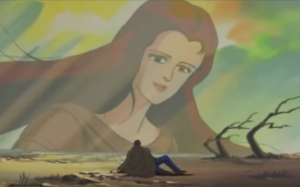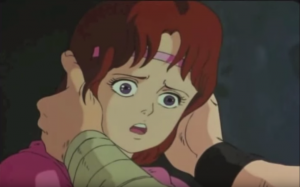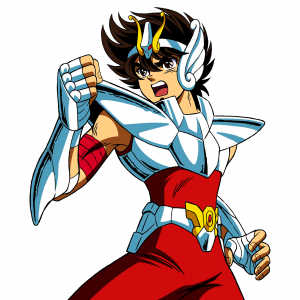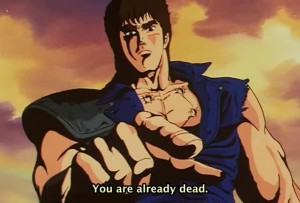Why You Should Read Hokuto no Ken Right Now
As I mentioned in my previous article, Saint Seiya was pretty heavily inspired by another manga named Hokuto no Ken which came out in 1983 and ran for five years. Written by Yoshiyuki Okamura (better known by his penname Buronson) and illustrated by Tetsuo Hara, Hokuto no Ken, also known as Fist of the North Star in English, became one of the biggest pop culture phenomena to ever come out of Japan. In its homeland, it single-handedly started a revolution of martial arts mangas with over the top attacks and manly protagonists, with certain works inspired by this genre, such as Bleach, Naruto and One Piece still enjoying immense success. Overseas Hokuto has also been extremely influential, with pretty much every single franchise that takes place in a desert or starring a single, proficient protagonist going around solving everyone’s problems being at least partially inspired by it (without even counting the American live-action adaptation whose quality is… questionable). While Hokuto was inspired by the American Mad Max movies, especially the second one, it has gone on to influence them, with the newest one, Mad Max: Fury Road feeling more like a Hokuto no Ken movie without any martial arts than like an actual Mad Max movie. Now, 30 years after the original manga was first published, new projects bearing the name continue to be made.
 Saint Seiya‘s popularity can be explained relatively easily – it was a very well-made manga that appealed to a large demographic and rode an already very high wave. But that wave was started by Hokuto – while there have been violent martial arts manga before, it was Hokuto that solidified the genre. But why? How come so many people fell in love with it? Sure, it was good, but there have been plenty of great manga over the years, and very few have endured the way Hokuto has. What is its secret? After all, on paper the concept sounds absolutely terrible – a boring guy who’s the best at everything going around a bland desert and solving everyone’s problems? No way that can ever go anywhere! And yes, in a way you’d make some pretty valid points, but the true strength of Hokuto aren’t its world, characters or story. It’s how they are all presented within the narrative. Let’s take a closer look at the manga’s very first chapter and see what we can get from it!
Saint Seiya‘s popularity can be explained relatively easily – it was a very well-made manga that appealed to a large demographic and rode an already very high wave. But that wave was started by Hokuto – while there have been violent martial arts manga before, it was Hokuto that solidified the genre. But why? How come so many people fell in love with it? Sure, it was good, but there have been plenty of great manga over the years, and very few have endured the way Hokuto has. What is its secret? After all, on paper the concept sounds absolutely terrible – a boring guy who’s the best at everything going around a bland desert and solving everyone’s problems? No way that can ever go anywhere! And yes, in a way you’d make some pretty valid points, but the true strength of Hokuto aren’t its world, characters or story. It’s how they are all presented within the narrative. Let’s take a closer look at the manga’s very first chapter and see what we can get from it!
Right from the beginning of the first chapter we’re given a dark and depressing look into the world of Hokuto no Ken – the world (or at least Japan, but it’s heavily implied that there are almost no areas that were unaffected by the conflict) has been devastated by a nuclear armageddon which reduced its population to the brink of extinction. Most, if not all animal species have been extinct, large areas are heavily irradiated, and resources such as food, gasoline or even water have become commodities. In order to survive, some have formed small communities in which they attempt to grow their own food on the mostly useless soil, while others have regressed to their most primal instincts and have become hunters, scavengers and bandits with their own societies (which are more like small armies that pillage whatever they come across). Almost none of this is narrated through the text – it’s all very visual imagery, like a young girl with a can of gasoline being chased by bandits. While other manga, such as Bleach, take its time to get us familiar with the characters and then introduce the world, Hokuto wants us to understand EXACTLY what kind of world we’re going to be exploring.
 It’d be so easy to introduce Kenshiro in the middle of battle, kicking ass and taking names. Hell, that’s how a lot of manga introduce their protagonists in order to show just how badass they are. In fact, a lot of movies and videogames do the same, starting with a high-action scene to catch the viewer’s attention and establish the main character’s fighting prowess. But that’s not what Kenshiro is about. Sure, he can make your head explode with a punch, but he has never been defined by his fighting ability, and Hokuto wants you to know it. While we do see the results of one of his rampages, we never see him actually fighting anyone. Instead, we see him stumble into a village exhausted and dehydrated. This is another important lesson about our protagonist – he’s not an all-powerful god. While he does possess immeasurable martial arts skills, he’s still very much human and is subject to the very same weaknesses that the average human is. Mistaking him for a bandit, the villagers quickly lock him up alongside an actual bandit – Bat, a young boy who grew up in the midst of the apocalypse and had to learn to survive in it. When Bat attempts to assault their warden – an 8 year old mute girl by the name of Rin, who was trying to bring them some water – Kenshiro not only refuses to help him, but actually pushes a pressure point on his arm to make him let go of Rin. When asked why he would sacrifice his freedom like this, Kenshiro merely responds with “What do you think would’ve happened to the girl had we escaped?” Placing innocent lives before his own has always been one of the character traits that has truly defined Kenshiro. Soon afterwards, we see him use his knowledge of pressure points to cure Rin of her muteness. This is the very first time we’ve seen him use his devastating powers… and it is to help a child speak.
It’d be so easy to introduce Kenshiro in the middle of battle, kicking ass and taking names. Hell, that’s how a lot of manga introduce their protagonists in order to show just how badass they are. In fact, a lot of movies and videogames do the same, starting with a high-action scene to catch the viewer’s attention and establish the main character’s fighting prowess. But that’s not what Kenshiro is about. Sure, he can make your head explode with a punch, but he has never been defined by his fighting ability, and Hokuto wants you to know it. While we do see the results of one of his rampages, we never see him actually fighting anyone. Instead, we see him stumble into a village exhausted and dehydrated. This is another important lesson about our protagonist – he’s not an all-powerful god. While he does possess immeasurable martial arts skills, he’s still very much human and is subject to the very same weaknesses that the average human is. Mistaking him for a bandit, the villagers quickly lock him up alongside an actual bandit – Bat, a young boy who grew up in the midst of the apocalypse and had to learn to survive in it. When Bat attempts to assault their warden – an 8 year old mute girl by the name of Rin, who was trying to bring them some water – Kenshiro not only refuses to help him, but actually pushes a pressure point on his arm to make him let go of Rin. When asked why he would sacrifice his freedom like this, Kenshiro merely responds with “What do you think would’ve happened to the girl had we escaped?” Placing innocent lives before his own has always been one of the character traits that has truly defined Kenshiro. Soon afterwards, we see him use his knowledge of pressure points to cure Rin of her muteness. This is the very first time we’ve seen him use his devastating powers… and it is to help a child speak.
But, of course, this wouldn’t be a martial arts manga if there weren’t any martial arts. Soon enough, the village is attacked by bandits who plan to steal its resources and do other despicable things. The bad news is that the only person who could possibly help them is locked up in the village’s prison. While Bat is desperately trying to reach the keys dropped by Rin, Kenshiro simply stands up, walks up to the bars and… Pulls them open, going through them. He could’ve left the prison whenever he wanted, but he didn’t to avoid getting Rin into trouble and because he didn’t want to startle the villagers. After all, how can you possibly help those you’ve sworn to protect when they don’t even trust you to follow their rules? But when push comes to shove, Kenshiro is perfectly willing to bend said rules for the common good. He finds the bandits and, naturally, quickly and easily dispatches of each of them, except for their leader, whom he hits several times over different parts of his body in quick succession. The leader falls on the ground, but quickly stands up. “Your little fists couldn’t hurt a fly!”, he gloats with a grin on his face. To which, Kenshiro merely responds with “You are already dead”. Moments later, the bandit’s head explodes in a painful, bloody mess. Kenshiro had pressed his vital points in order to manipulate his blood pressure to the boiling point. He intentionally didn’t give him a quick, painless death – Kenshiro wanted his opponent to suffer. Because, in his eyes, that’s what you deserve when you hurt the innocent. Having saved the village single-handedly, Kenshiro departs, but he is not alone – Bat and Rin have chosen to follow him. For the first time since his journey started, he will not be alone in it.
Within the span of 20 short pages, Hokuto no Ken has taught us absolutely everything about its world and its characters, with almost no exposition except for when it was absolutely necessary (I doubt many people would get the exact nature of Kenshiro’s abilities if it wasn’t explained to them). And while the setting of a desolate desert where people have turned into savages is not new at all (you can see it in practically every single post-apocalyptic film, book, manga or game), but the notion of a protagonist who is not out for revenge, or for love, or to survive, but to try to make the place even just a little bit better than it is, was a very new one for the genre, and it still is today. Kenshiro as a character was never out to get stronger – as a matter of fact, he never really received any progression as a character, and never became more powerful than he was in the beginning. The real focus of the manga was on how he, as a constant, would influence the world and characters around him. That was why it was a brilliant idea to also have Rin and Bat tag along with him – while they were never really important characters, they provided a fresh perspective on Kenshiro and could evolve instead of him. And they did, ending the series as warriors worthy of continuing Kenshiro’s legacy.
I can go on and on about all the brilliant moments and characters throughout Hokuto no Ken, but I think I’ll leave you to discover them all on your own. The manga is, of course, a great place to start, but the (surprisingly faithful, if censored) anime adaptation from 1984 is also an option for those of you who prefer their pictures to move (you can purchase it in its entirety on DVD for relatively cheap). In addition, several more recent animated movies loosely adapting certain arcs of the manga were released between 2005 and 2008, to commemorate the 25th anniversary of the franchise. And if you’d much rather experience the story in an interactive medium, then Fist of the North Star: Ken’s Rage and its sequel Ken’s Rage 2 are excellent, as they adapt the entire story of the manga into a 3rd person brawler. Ken’s Rage only adapts the first half of the manga, but has an English dub as well, while Ken’s Rage 2 adapts all of it, but only features the Japanese voices (though, in fairness, the second arc, which deals with Kenshiro’s homeland, is not very good). Additionally, both games feature lots of extra modes where you can play as various characters alone or in co-op, and those differ between games, so if you’d like to get the complete experience then I’d recommend picking up both, but if you only want the complete story and don’t care about the English dub then just skip to Ken’s Rage 2. Regardless of what non-live action medium you choose to experience Hokuto no Ken in, I can almost guarantee that it will always be worth it!

 Let me take you back to early 80s Japan. The country’s economy is in a boom – the highest point since the war, with an average of 4% growth per year throughout the decade. Unemployment is at less than 5%. Japanese people suddenly found themselves with a lot of disposable income, which led to a natural increase in entertainment products, such as movies and comic books. Additionally, videogames such as Donkey Kong and Super Mario Bros. gain Japan worldwide recognition, forever sealing its place as the premier developer of videogames – a position that it would hold for at least the next 20 years, and arguably for a lot more. But there was another character created around the same time who, while not nearly as popular as Mario, proved to be just as influential. His name… is Kenshiro.
Let me take you back to early 80s Japan. The country’s economy is in a boom – the highest point since the war, with an average of 4% growth per year throughout the decade. Unemployment is at less than 5%. Japanese people suddenly found themselves with a lot of disposable income, which led to a natural increase in entertainment products, such as movies and comic books. Additionally, videogames such as Donkey Kong and Super Mario Bros. gain Japan worldwide recognition, forever sealing its place as the premier developer of videogames – a position that it would hold for at least the next 20 years, and arguably for a lot more. But there was another character created around the same time who, while not nearly as popular as Mario, proved to be just as influential. His name… is Kenshiro. Hokuto‘s popularity gave rise to martial arts mangas that followed the same formula. Numerous attempts were made, some successful (such as 1984’s DragonBall) and some not. One of those attempts was Saint Seiya, created by Masami Kurumada. While not a direct ripoff of Hokuto, the influences were obvious – Saint Seiya also had a highly masculine protagonist (though more emotionally than physically) who used martial arts to right wrongs. But there were also several differences – for example, instead of a desolate wasteland, the Saints (Saint Seiya‘s word for martial artist) fought in a world that mixed sci-fi and Greek mythology settings, and instead of a sole protagonist wandering with a small supporting cast that mostly cheer him on, main character Seiya was joined by four other Saints. But there was another extremely important difference, one that I believe helped elevate Saint Seiya above the status as “just another martial arts” manga. While Hokuto no Ken was aimed at adults, with hyper-violence, complex themes and often depressing or bittersweet endings, and DragonBall was unquestionably aimed at little boys, with a child protagonist, simple plots and unquestionably evil bad guys, Saint Seiya managed to hit the tonal middle ground in order to appeal to almost everyone.
Hokuto‘s popularity gave rise to martial arts mangas that followed the same formula. Numerous attempts were made, some successful (such as 1984’s DragonBall) and some not. One of those attempts was Saint Seiya, created by Masami Kurumada. While not a direct ripoff of Hokuto, the influences were obvious – Saint Seiya also had a highly masculine protagonist (though more emotionally than physically) who used martial arts to right wrongs. But there were also several differences – for example, instead of a desolate wasteland, the Saints (Saint Seiya‘s word for martial artist) fought in a world that mixed sci-fi and Greek mythology settings, and instead of a sole protagonist wandering with a small supporting cast that mostly cheer him on, main character Seiya was joined by four other Saints. But there was another extremely important difference, one that I believe helped elevate Saint Seiya above the status as “just another martial arts” manga. While Hokuto no Ken was aimed at adults, with hyper-violence, complex themes and often depressing or bittersweet endings, and DragonBall was unquestionably aimed at little boys, with a child protagonist, simple plots and unquestionably evil bad guys, Saint Seiya managed to hit the tonal middle ground in order to appeal to almost everyone.